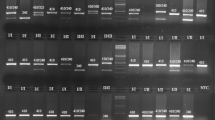Abstract
Background
P-selectin and P-selectin glycoprotein ligand-1 (PSGL-1) regulate the initial interactions between leukocytes, activated platelets and endothelial cells. Recently, a variable number of tandem repeats (VNTR) polymorphism in PSGL-1 gene affecting the length of the extracellular domain of PSGL-1 and the distance of the P-selectin binding site to the cell surface has been described. There are limited numbers of studies reporting PSGL-1 polymorphism might affect the inflammatory response and thrombosis. We explored the association between PSGL-1 VNTR polymorphisms (especially AB genotype that has the most deformed configuration of the binding site) and the development of coronary stent restenosis and stent thrombosis in patients with coronary artery disease (CAD).
Materials and methods
Eighty-seven patients with in-stent restenosis and 93 patients with patent coronary stents were included into the study. The distributions of age, gender, hypertension, diabetes, smoking, total cholesterol and triglyceride levels were similar between the groups. Genomic DNAs were obtained by standard methods from whole blood samples. Specific primers were used to amplify PSGL-1 gene by polymerase chain reaction (PCR).
Results
Three alleles and 5 different genotypes were detected. In the in-stent restenosis group; allele frequencies were 79.5% for A allele, 18.1% for B allele and 2.4% for C allele and in the patent stent group; allele frequencies were 79.3% for A allele, 20.1% for B allele and 0.6% for C allele. The allele frequencies were similar between the in-stent restenosis group and patent stent group (P = 0.97 for A allele, P = 0.73 for B allele and P = 0.19 for C allele). Genotype distributions were also similar between the groups. There were not any significant associations between PSGL-1 AB genotype and stent restenosis (31.3% vs. 27.2%, P = 0.54), repetitive stent restenosis (33.3% vs. 28.8%, P = 0.82) or in-stent thrombosis (44.4% vs. 28.2%, P = 0.37). In neither male patients nor female patients, there was any significant association between AB genotype and restenosis (32.2% vs. 24.3% P = 0.31 and 29.2% vs. 38.9% P = 0.51, respectively). However, among patients with a family history of early CAD, significantly higher percentage of AB genotype was found in those with stent restenosis (41.4% vs. 18.8%, P = 0.03).
Conclusions
No significant association was found between PSGL-1 VNTR polymorphisms and in-stent restenosis. However, in patients with a family history of early CAD presence of PSGL-1 AB genotype might increase the risk of in-stent restenosis.
Similar content being viewed by others
References
Petrovic D, Peterlin B (2005) Genetic markers of restenosis after coronary angioplasty and after stent implantation. Med Sci Monit 11:RA127–135
Wijpkema JS, Van Haelst PL, Monraats PS, et al (2006) Restenosis after percutaneous coronary intervention is associated with the angiotensin-II type-1 receptor 1166A/C polymorphism but not with polymorphisms of angiotensin-converting enzyme, angiotensin-II receptor, angiotensinogen or heme oxygenase-1. Pharmacogenet Genomics 16:331–337
Afshar-Kharghan V, Diz-Küçükkaya R, Ludwig EH, Marian AJ, Lopez JA (2001) Human polymorphism of P-selectin glycoprotein ligand 1 attributable to variable numbers of tandem decameric repeats in the mucinlike region. Blood 97:3306–3307
Hancer VS, Diz-Kucukkaya R, Nalcaci M (2005) Turkish population data on the factor XIII Val34Leu, glycoprotein (GP)Ibα Kozak and P-selectin glycoprotein ligand 1 (PSGL-1) loci. Cell Biochem Funct 23:55–58
Mayadas TN, Johnson RC, Rayburn H, Hynes RO, Wagner DD (1993) Leukocyte rolling and extravasation are severly compromised in P-selectin-deficient mice. Cell 74:541–554
Ley K, Bullard DC, Arbones ML, et al (1995) Sequential contribution of L- and P-selectin to leukocyte rolling in vivo. J Exp Med 181:669–675
Yang J, Hirata T, Croce K, et al (1999) Targeted gene disruption demonstrates that P-selectin glycoprotein ligand-1 (PSGL-1) is required for P-selectin-mediated but not E-selectin-mediated neutrophil rolling and migration. J Exp Med 190:1769–1782
Palabrica TM, Furie BC, Konstam MA, et al (1989) Thrombus imaging in a primate model with antibodies spesific for an external membrane protein of activated platelets. Proc Natl Acad Sci USA 86:1036–1040
Palabrica T, Lobb R, Furie BC, et al (1992) Leukocyte accumulation promoting fibrin deposition is mediated in vivo by P-selectin on adherent platelets. Nature 359:848–851
Celi A, Pellegrini G, Lorenzet R, et al (1994) P-selectin induces the expression of tissue factor on monocytes. Proc Natl Acad Sci USA 91:8767–8771
Sullivan VV, Hawley AE, Farris DM, et al (2003) Decrease in fibrin content of venous thrombi in selectin-deficient mice. J Surg Res 109:1–7
Myers DD, Hawley AE, Farris DM, et al (2003) P-selectin and leukocyte microparticles are associated with venous thrombogenesis. J Vasc Surg 38:1075–1089
Falati S, Gross P, Merrill-Skoloff G, Furie BC, Furie B (2002) Real-time in vivo imaging of platelets, tissue factor and fibrin during arterial thrombus formation in the mouse. Nat Med 8:1175–1181
Falati S, Liu Q, Gross P, et al (2003) Accumulation of tissue factor into developing thrombi in vivo is dependent upon microparticle P-selectin glycoprotein ligand 1 and platelet P-selectin. J Exp Med 197:1585–1598
Johnson-Tidey RR, McGregor JL, Taylor PR, Poston RN (1994) Increase in the adhesion molecule P-selectin in endothelium overlying atherosclerotic plaques: coexpression with intercellular adhesion molecule-1. Am J Pathol 144:952–961
Ridker PM, Buring JE, Rifai N (2001) Soluble P-selectin and the risk of future cardiovascular events. Circulation 103:491–495
Roldan V, Gonzalez-Conejero R, Marin F, Pineda J, Vicente V, Corral J (2004) Short alleles of P-selectin glycoprotein ligand-1 protect against premature myocardial infarction. Am Heart J 148:602–605
Lozano ML, Gonzalez-Conejero R, Corral J, et al (2001) Polymorphisms of P-selectin glycoprotein ligand – 1 are associated with neutrophil-platelet adhesion and with ischaemic cerebrovascular disease. Br J Haematol 115:969–976
Bugert P, Hoffmann MM, Winkelmann BR, et al (2003) The variable number of tandem repeat polymorphism in the P-selectin glycoprotein ligand – 1 gene is not associated with coronary heart disease. J Mol Med 81:495–501
Author information
Authors and Affiliations
Corresponding author
Rights and permissions
About this article
Cite this article
Ozben, B., Diz-Kucukkaya, R., Bilge, A.K. et al. The association of P-selectin glycoprotein ligand-1 VNTR polymorphisms with coronary stent restenosis. J Thromb Thrombolysis 23, 181–187 (2007). https://doi.org/10.1007/s11239-006-9020-9
Published:
Issue Date:
DOI: https://doi.org/10.1007/s11239-006-9020-9




